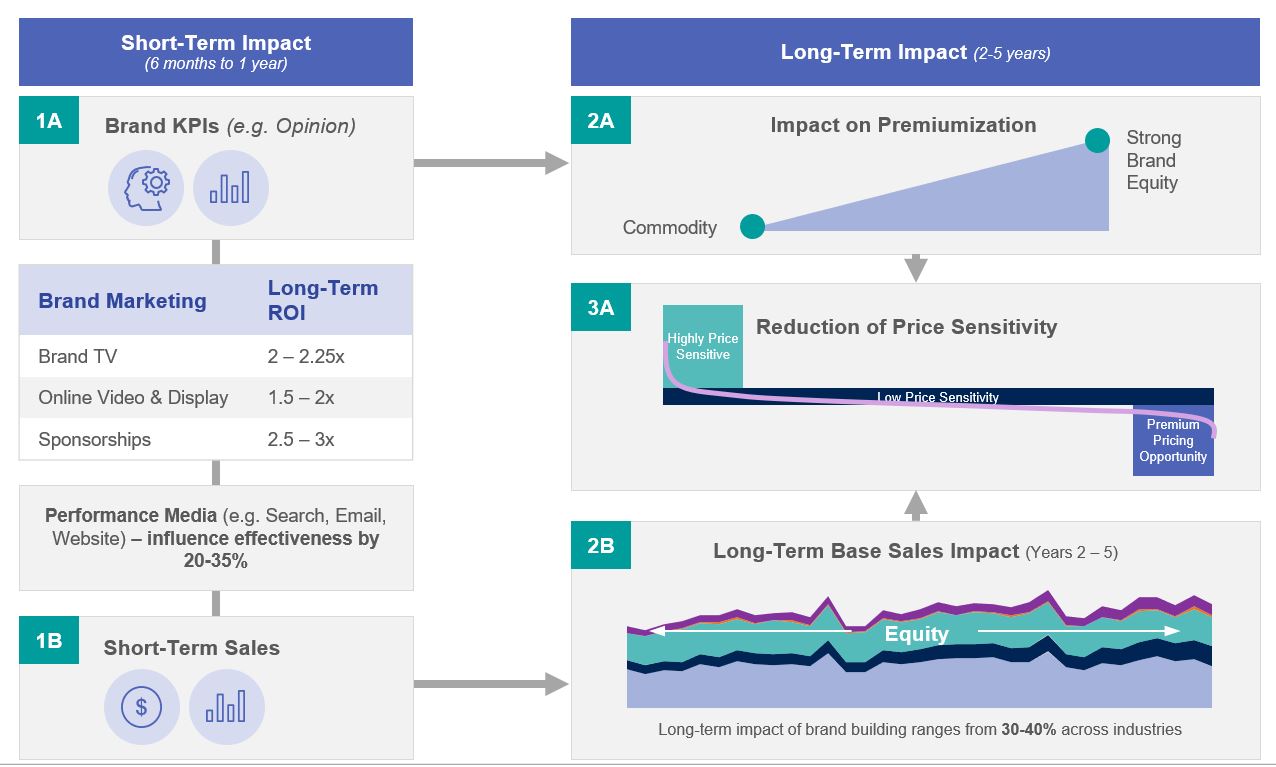By Doug Brooks, EVP at Ipsos MMA
It’s been an age-old debate between marketing and finance executives. What is the value of brand building initiatives and how can they be measured if an impact can’t be seen in the short-term, how do we know what the affect will be over the long-term? Without clear evidence of the long-term value and impact of brand building initiatives, they are often one of the first items on the list for cutting when budgets are being slashed during challenging times. This however is exactly what companies shouldn’t be doing on a wholesale basis as brand building marketing has been shown to not only help during difficult times but enables a brand to reemerge faster and stronger.
But it gets even more complicated – unfortunately and all too often, investments in brand marketing are reduced and reallocated toward short-term focused tactics, such as pricing, promotions and performance media. Insights from MMA’s Benchmark Database spanning the past few decades provide clear evidence that brands that “stay the course” in an efficient and effective manner can weather the storm and, in most cases, out-perform their competition and category as the marketplace recovers. Thomas Jefferson said: “The man who stops advertising to save money is like the man who stops the clock to save time”. He was right. The challenge that many executives face today is the absence of fact-based data; most fall victim to what turns into very expensive decisions based on fear and gut-based decisions.
“Numerous case studies analyzing marketing effects in a recession all point to the same approach – invest similarly or even increase investment in advertising. It helps retain market share during the turmoil and grow market share on the other side,” said Simon Peel, Global Head of Media at Adidas “I hope marketers and their C-Suite take note of the evidence and apply it.”
It is critical if not essential to understand that the decision-making landscape has and is undergoing massive changes. Virtually every company has a treasure trove of data that while perhaps buried and disorganized, is available to inform fact-based decisions that can be converted into significant financial advantages by driving brand building initiatives that can be put to work in good times, and bad.
Below is an example of the impact that brand building initiatives have on both short-term and long-term business performance:
Framework for Understanding
the Impact of Brand Building Investment

Brand building TV, Online Video and Sponsorships have a measurable long-term impact on brands. Ipsos MMA benchmarks show impacts as high as 2x-3x that of short-term investments.
- 1A) Brand Marketing impacts consumer opinion, attitudes and overall brand equity.
- 1B) While influencing equity, brand marketing investments also influence the effectiveness of performance media channels such as search, email, owned media and website engagement.
- 2A) When these investments impact Brand KPIs, there is a measurable impact on sales that lasts for a period of 2-5 years.
- 2B) Maintaining or in some cases increasing Brand KPIs enables brands to maintain or improve their position on the spectrum of commodity vs premium brands.
- 3A) Maintaining brand equity enables brands to maintain or reduce price sensitivity. Increases in consumer price sensitivity as a result of cuts in brand building and increases in promotional activities are expensive over the long-term.
Companies that lose sight of their long-term marketing strategy and succumb to the temptation to cut brand building programs, will do so to the detriment of their brand.
Cutting brand building can produce negative impacts on a brand, including:
- Costly brand rebuilding initiatives – the cost to address a decline in brand equity is typically 2x the savings of reducing the brand investment.
- Shifting the balance of investments from brand building to performance media doesn’t work – Ipsos MMA benchmarks show that 20% to as high as 35% of the effectiveness of performance media is driven by brand building or upper funnel media. When the two forms of investment fall “out-of-balance” the negative impact on short-term sales could be significant. Performance media should be thought of and planned for as channels that are used to convert demand generated by upper funnel or brand media.
- Reductions in brand building drive an increase in price sensitivity and a reliance on promotions, incentives and reductions in base pricing to maintain sales volume.
Through the use of data and predictive analytics, brands now have the ability to optimize marketing investments in a unified and holistic manner while maintaining minimum thresholds of brand marketing to sustain brand equity, support the effectiveness of performance media and reduce the risk of eroding your brand by reducing premium status and increasing price sensitivity.
Learn more about marketing strategies and planning for disruption and recovery



